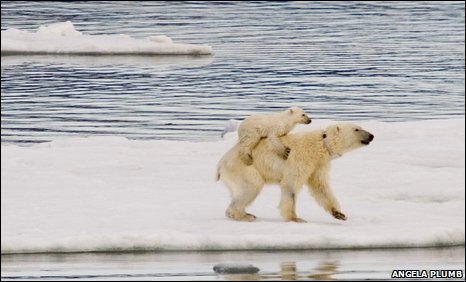You gotta love the fact they caught this on camera
http://news.bbc.co.uk/earth/hi/earth_news/newsid_8284000/8284906.stm
Polar bear cub hitches a ride

http://news.bbc.co.uk/earth/hi/earth_news/newsid_8284000/8284906.stm
Polar bear cub hitches a ride

Arctic waters are at best chilly and at worst close to freezing. Which may explain why a polar bear cub has recently been seen riding on the back of its mother as the bears swim across parts of the Arctic Ocean. The cub then briefly rode her back as she clambered out of the icy water, a unique event photographed by a tourist.
Experts have rarely seen the behaviour, and they say the latest find suggests it may be a more common practice than previously thought. Dr Jon Aars from the Norwegian Polar Institute in Tromso describes what happened in the journal Polar Biology. On the 21 July 2006, Mrs Angela Plumb, a tourist from the UK, was aboard a ship in the mouth of a fjord in the Svalbard archipelago.
Holidaying in the wildlife hotspot of Duvefjorden, Nordaustlandet, Mrs Plumb spotted the mother bear with a seven-month-old cub hitching a ride on her back. "The cub was on the back of the polar bear when it was in the water, then it got out of the water and stayed on its mother's back a little, then she shook it off," Mrs Plumb explains. For large parts of the year, polar bears (Ursus maritimus) live among the sea ice, feeding mainly on seals.
The challenge for the bears is to navigate the many areas of open water between the islands of floating ice. Seeing the bear had a radio collar, Mrs Plumb got in touch with Dr Aars to report her sighting and asked if this was a common behaviour. "I hadn't seen this behaviour before or heard about it so I asked other researchers and found out it is something that has been observed but not frequently at all," Dr Aars says.
Out of the cold
Cubs are known to ride their mother's back when moving through deep snow as they leave their den areas. Cubs of other bear species such as the sloth bear also ride on their parents. However, the the extent to which polar bear cubs hitch a ride on swimming adults in open water is unknown. Dr Aars was especially interested if this behaviour might have some adaptive value for the bears.
"This could be potentially important because it means that the cubs get exposed to less water. If they are in the water they would have to swim and very small cubs are very badly insulated in water," he says. Adults are well adapted to swimming in the cold water with insulating subcutaneous fat and and large body mass. However, young bears have very little insulating fat, as they do not develop brown fat stores until adulthood. Their fur coat also loses most of its insulating properties if immersed in ice water. Dr Aars suggests staying out of the water could be vital for the cub's ability to survive in habitats where sea ice is scattered across open ocean.
Speedy transport
Another reason for the behaviour could be that it aids the mother's mobility in the water. "I would imagine a big benefit is the ride is faster, an adult female polar bear is a strong swimmer, cubs of this size are much slower and time in water is time lost hunting," suggests Professor Andrew Derocher from the University of Alberta, Edmonton, Canada. "The mother would rather put her time into gaining more food by reaching good habitat rather than swimming and using energy," he explains.
The scientists are interested to find out if this behaviour might be a regular occurrence within the polar bear population. "It's important to remember the vast areas it may happen in. It has not been observed that much, but it could be more common than we think," says Dr Aars. Prof Derocher also wonders if the people who share the bears' habitat might be able to help unravel this behaviour.
"It would be interesting to hear if Inuit have seen this behaviour, I'm always very impressed that our observations match what local people have seen before, but they don't tell you about them unless you ask."
